Welcome to How Often to Mist Air Plants: A Complete Guide! As an avid collector of air plants, I’ve made every mistake in the book when it comes to watering these intriguing houseplants. I’ve shriveled them up by under-misting, rotted them with overzealous soaking, and pretty much everything in between. After years of trial and error, I’ve finally cracked the code on the ideal misting schedule.
It’s no wonder many plant parents struggle to keep their air plants alive – a shocking 50% of air plants die within the first year of getting them. Proper watering is by far the number one challenge. The key is understanding the balance between misting and soaking tailored to your specific plant variety.
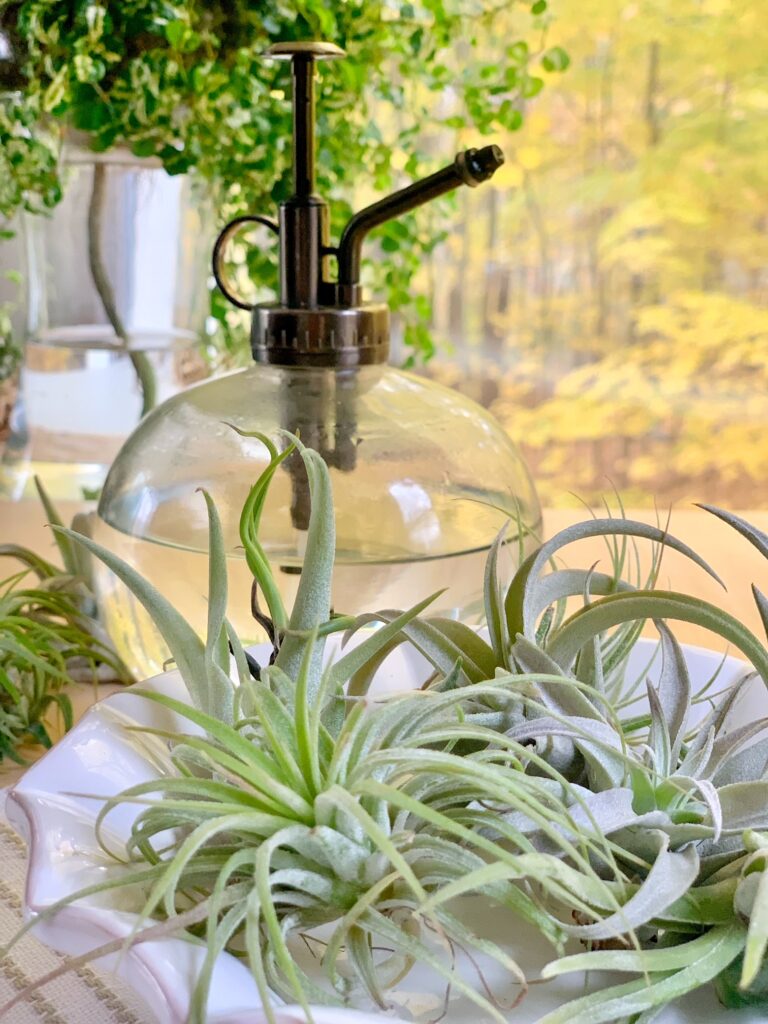
In this comprehensive guide, you’ll learn everything you need to know about watering air plants. I’ll share details on the unique anatomy that makes their care different, how light impacts your watering regimen, specific misting and soaking recommendations, and tips to get your watering routine just right. Let’s restore peace to your plant parenthood journey by taking the guesswork out of watering your air plants. No more frustration and disappointing shriveled plants!
*This post includes affiliate links, for more info on affiliate links visit here
Natural Habitats of Air Plants
Air plants, scientifically known as Tillandsia, hail from diverse natural habitats. These unique plants are primarily found in tropical and desert regions across the Americas. Their remarkable adaptability has allowed them to thrive in a wide range of environments. In the tropical rainforests, Air plants like spanish moss (Tillandsia usneoides) drape themselves over tree branches, absorbing nutrients and moisture from the humid air. In contrast, some Tillandsia species have made their homes in arid deserts, where water is scarce. These desert dwellers have evolved to rely on sparse rainfall and occasional fog to sustain themselves. Their epiphytic nature, meaning they grow on other surfaces without being parasitic, has further fueled their ability to adapt and flourish in various ecosystems. This remarkable range of natural habitats showcases the resilience and resourcefulness of air plants, making them a fascinating group of botanical wonders.
Key Differences Between Xeric and Mesic Species
Xeric air plants are adapted to hot, arid environments like deserts. They have dense, white trichome coatings that help maximize moisture absorption from limited water sources. The thick trichomes also reflect harsh sunlight in their dry climate. Examples of popular xeric species are Tillandsia xerographica and Tillandsia harrisii, which have iconic silvery gray foliage.
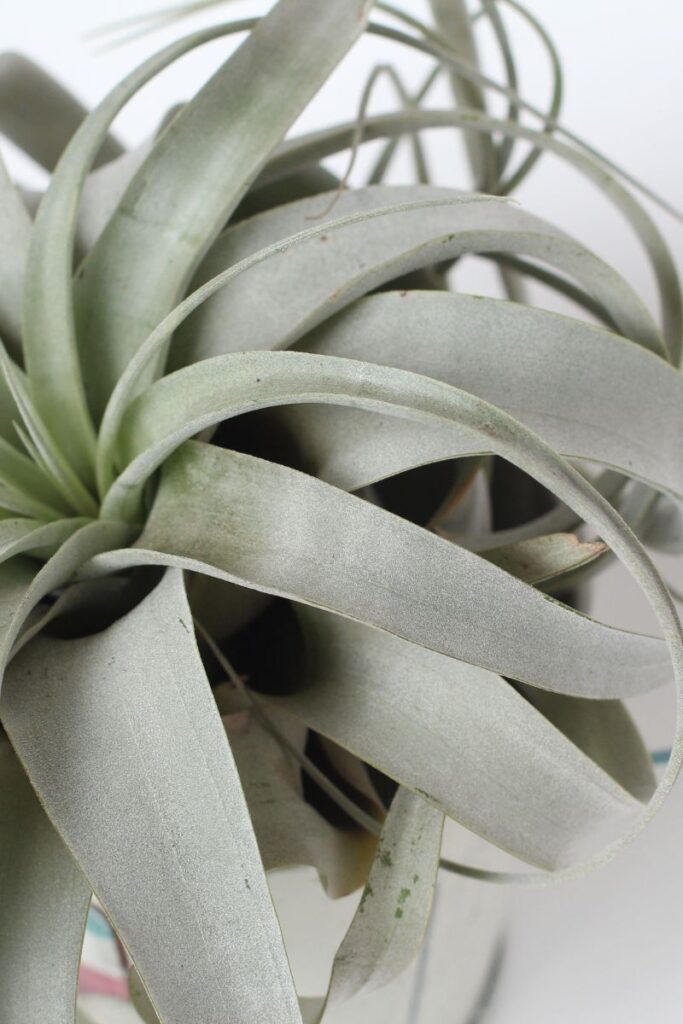
Mesic air plants hail from humid tropical areas and rainforests. They have sparser, thinner trichomes and greener foliage since they receive much more frequent rainfall. Their higher water needs make mesic air plants a bit more challenging for indoor growing. But their beautiful green foliage adds vibrancy. Popular mesic species are Tillandsia ionantha and Tillandsia juncea.
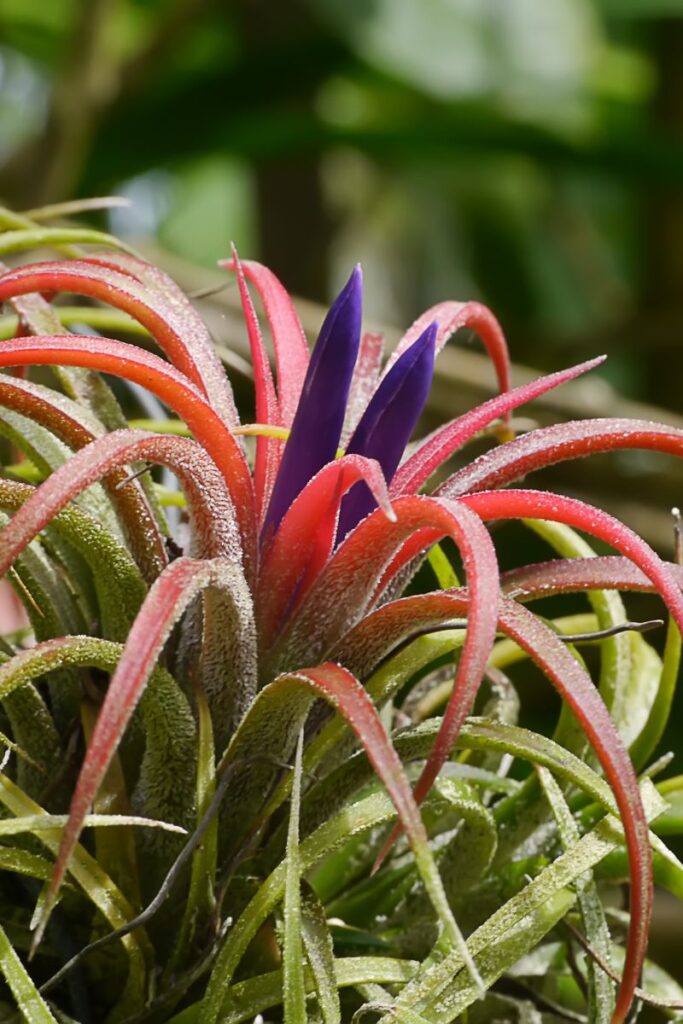
Understanding Trichomes: The Key to Caring for Air Plants
Air plants absorb water and nutrients through structures on their foliage called trichomes, the white fuzzy coat of the air plant leaves. Trichomes are modified scales or hairs that cover the leaves and stems of air plants.
Depending on the species and native climate, the appearance of trichomes will differ.
Xeric Air Plants: Adapted for Arid Environments
Xeric air plants have larger, dense, white trichomes to efficiently absorb moisture from limited water sources like fog. The thick trichome coat also reflects sunlight in harsh desert conditions.
Mesic Air Plants: Thriving in Lush Environments
Mesic air plants have smaller, sparser trichomes since they receive much more frequent rainfall in tropical areas. Their thinner trichome coating gives them a green vs gray appearance.
These structural differences in trichomes dictate the watering frequency needed. The dense trichomes of xeric plants retain more moisture, while the thinner trichomes of mesic plants require consistent watering.
Understanding the purpose and diversity of trichomes is key to providing proper watering for each air plant type. The unique trichome structures are the reason air plants can survive without soil and absorb everything they need from moisture on leaves and stems alone.

3 Ways to Water Indoor Air Plants
Without soil, naturally occurring rainwater, or humid conditions an air plant parent is tasked with providing their air plants (Tillandsias) the moisture they need. There are two watering methods and when both are used you will find your air plants thriving. The first is the misting method, the second is a weekly and bi-weekly soak. The frequency will depend on which type of tillandsia you have as well as how dry or humid your home is.
1. Misting Your Air Plants
With a water plant mister or spray bottle, you can simply spray your air plant 2-3 times a week. Make sure the entire plant is sprayed. Once sprayed make sure there is plenty of air circulation so the plant can dry quickly. Air plants can rot if they are in spaces without plenty of air. For some Xeric air plants misting a few times, a week may be enough. However, most air plants and certainly Mesic plants (the greener types) will need a combination of misting and soaking to receive the moisture they need to survive.
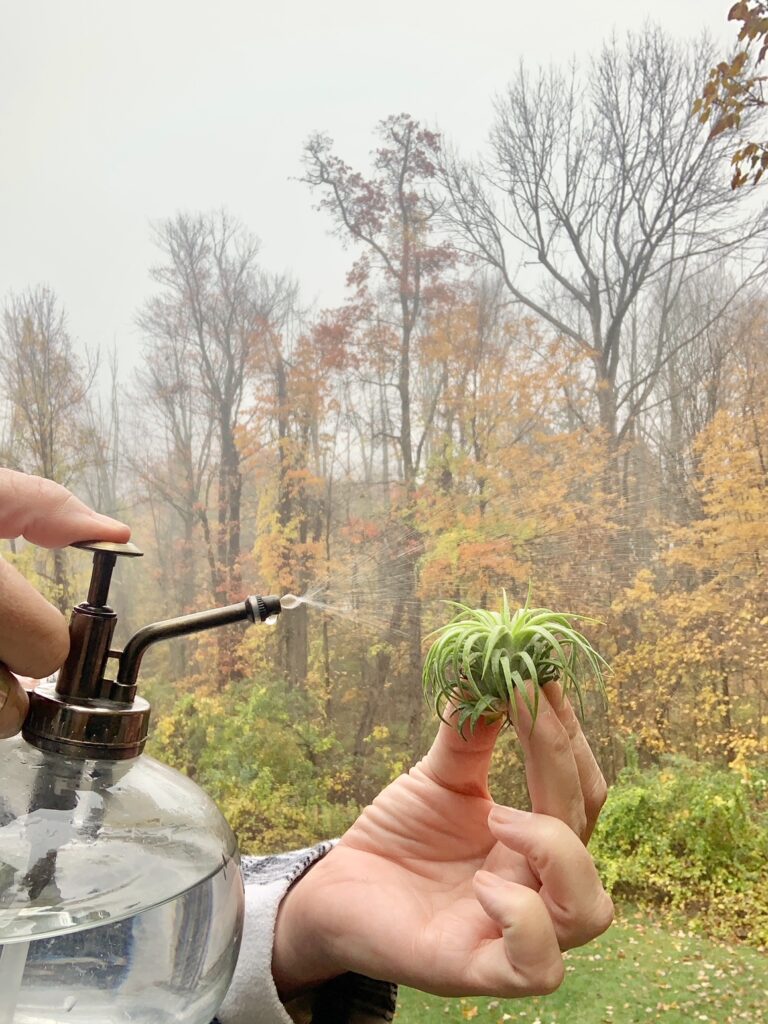
Note: If your air plant is in a humid environment like a greenhouse, just misting may be sufficient.
2. Dunking Your Air Plants
Dunking is an alternative method for watering air plants. To dunk your Tillandsia, you’ll need a container that’s large enough to fully submerge the plant. Simply place your air plant in the container, ensuring it’s completely covered by water. Let it soak for about 20-30 minutes, allowing the plant to absorb moisture through its trichomes (fuzzy leaves). After dunking, gently shake off any excess water and place the air plant in an area with good air circulation to ensure it dries completely. Dunking is especially useful if you have a collection of Xeric air plants or if you prefer a different watering routine. Remember, the key to successful air plant care is understanding the specific needs of your plants, whether you choose to mist, soak, or combine both methods.
3. Soaking Your Tillandsia
Most Tillandsia enthusiasts will agree, soaking your indoor plants once every week is your best bet when watering your air plants. As mentioned above, in unusually high humid environments or with some Xeric type plants just misting may be sufficient. But with most, a good water bath is ideal. Below is a “How to” on soaking your air plants but first – whether you mist, soak, or do a combination of both there are some special considerations for the type of water.
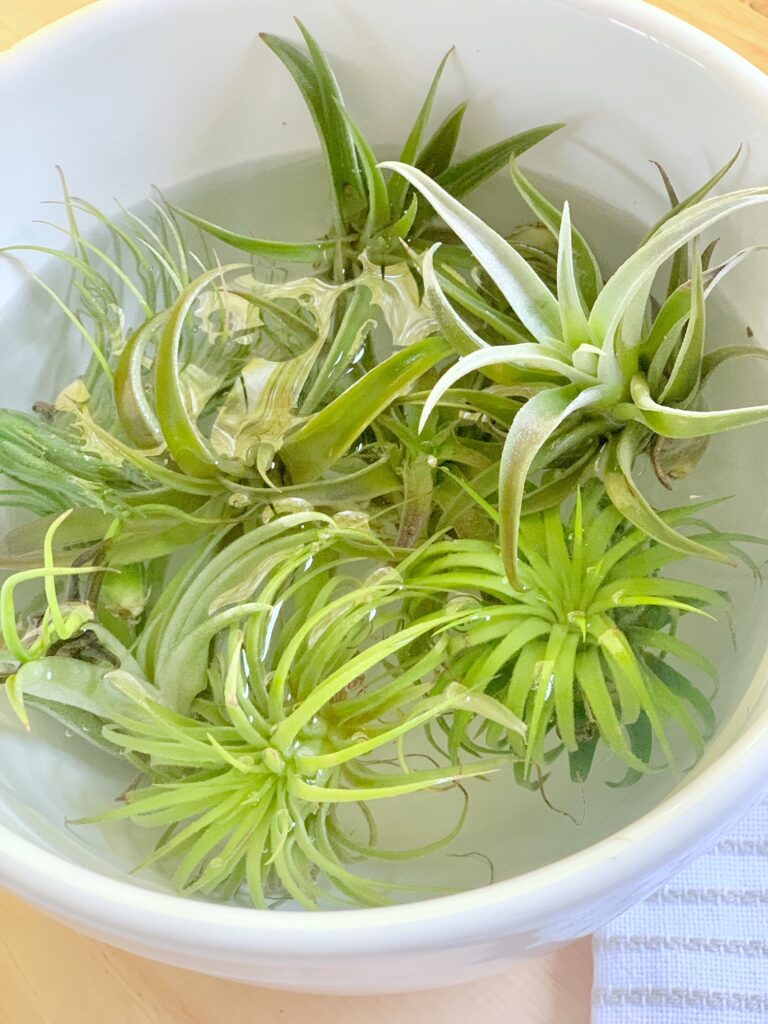
Air Plants soaking in a bowl of water.
Additional Care Basics for Air Plants
Caring for air plants doesn’t have to be complicated. Here are some simple guidelines to help you keep your air plants healthy and happy:
Light Requirements: Air plants thrive in bright, indirect light. They don’t need direct sunlight, so keep them out of direct sun to prevent scorching. A spot near a window with filtered sunlight is perfect.
Ideal Temperatures: Air plants are like Goldilocks – they prefer temperatures that aren’t too hot or too cold. Aim for a range between 50°F to 90°F (10°C to 32°C). Avoid freezing temperatures, and they’ll be content.
Air Circulation Needs: Air plants love good airflow. Regular circulation helps prevent mold and keeps them fresh. If your environment is stuffy, consider a small fan or occasional gentle shaking to mimic the breeze.
Water Quality: When it comes to watering, air plants are particular. Use rainwater, distilled water, or tap water that has been left out overnight to let chlorine dissipate. Avoid softened water as the salt can harm them. They like a good soak for about 20-30 minutes once a week, especially in drier climates.
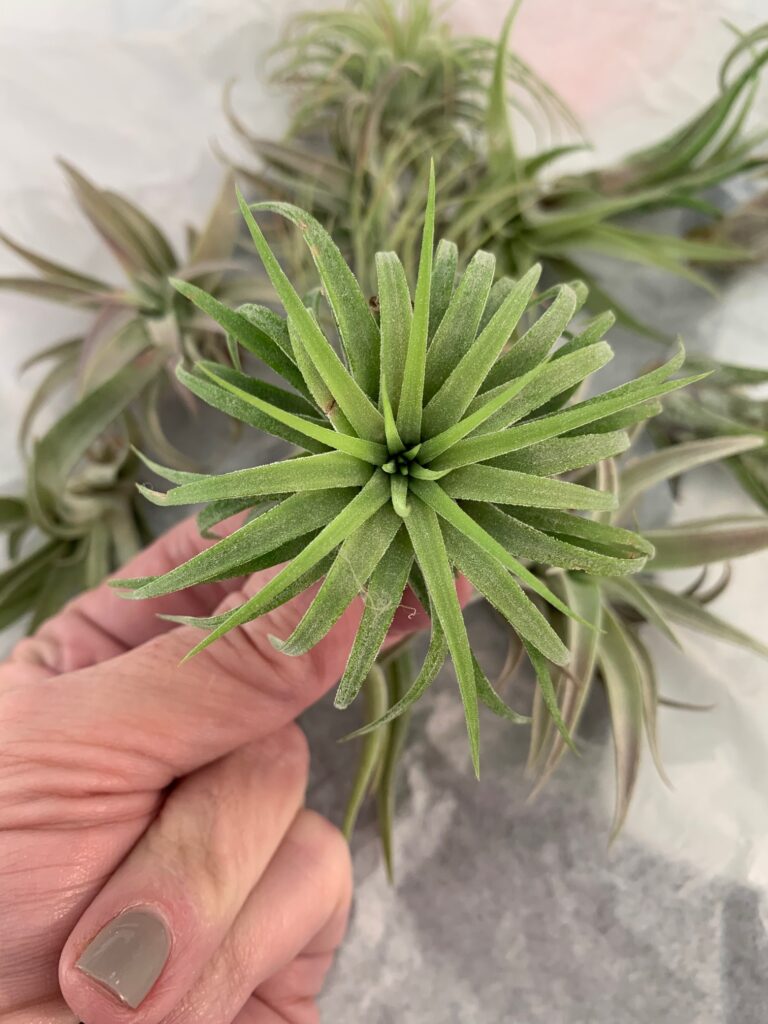
Signs of Overwatering:
- Wilting: If your air plant appears droopy or its leaves start to curl inwards, it may be getting too much water.
- Leaf Rot: Excess moisture can lead to the base of the leaves turning brown or black. This is a clear sign of overwatering.
- Yellowing or Browning: Overwatered air plants often exhibit yellow or brown patches on their leaves.
- Funky Odor: If your air plant begins to emit a foul smell, it might be due to excessive moisture, which can encourage mold and rot.
- Leaves Feel Squishy: When you touch the leaves and they feel soft or squishy, it’s an indication of too much water.
Signs of Underwatering:
- Dry Leaves: If the leaves appear excessively dry, curled, or shriveled, your air plant is likely thirsty.
- Pale or Dull Color: Underwatered air plants can lose their vibrant green color, appearing pale or grayish.
- Slow Growth: When your air plant’s growth rate significantly decreases, it may be lacking water.
- Leaf Tip Curl: The tips of the leaves may curl or twist when underwatered.
- Brown or Crispy Edges: Insufficient moisture can cause the leaf edges to turn brown and become brittle.
Your Overwatering/Underwatering Cheat Sheet
| Signs of Overwatering | Signs of Underwatering |
|---|---|
| Wilting | Dry Leaves |
| Leaf Rot | Pale or Dull Color |
| Yellowing or Browning | Slow Growth |
| Funky Odor | Leaf Tip Curl |
| Leaves Feel Squishy | Brown or Crispy Edges |
Remember that finding the right watering balance is essential for the health of your air plants. Adjust your watering routine based on these signs to keep them flourishing.
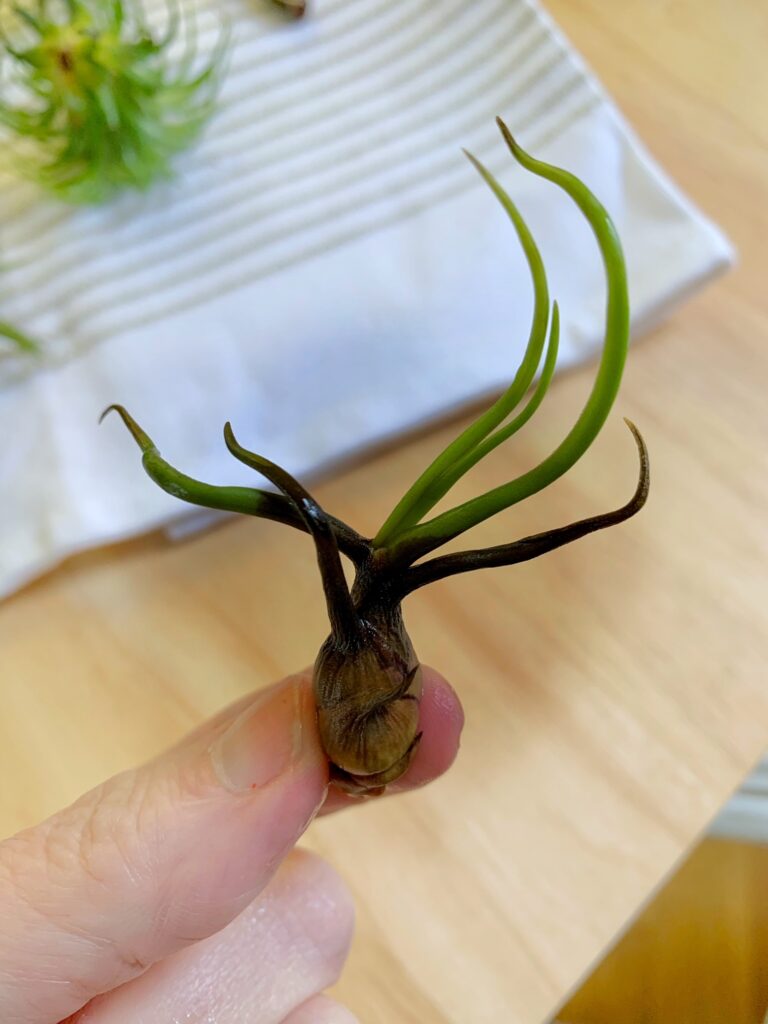
Signs of an overwatered Air Plant.
Mounted vs Unmounted Plant Considerations
When it comes to air plants, the choice between mounting them or leaving them unmounted significantly influences your watering routine. Mounted air plants, attached to surfaces like wood or rocks, tend to dry faster as they receive more air circulation. Consequently, they often require slightly more frequent watering. On the other hand, unmounted air plants, when placed in decorative containers or arrangements like a glass terrarium, retain moisture for longer periods, allowing for less frequent watering. Whether mounted or unmounted, understanding these distinctions helps you tailor your care to meet the unique needs of your air plants, ensuring they thrive in their chosen display setup.
Additionally, it’s essential to note that some mounted displays may pose challenges when using the soak method for watering, as the attachment to a surface can make submerging the entire plant difficult. In contrast, loose or unmounted air plants are more versatile and readily lend themselves to soaking, simplifying the watering process. In my Air Plant Candle ring design, the air plants are placed atop a grapevine wreath, allowing for easy removal when it’s time for their soak.
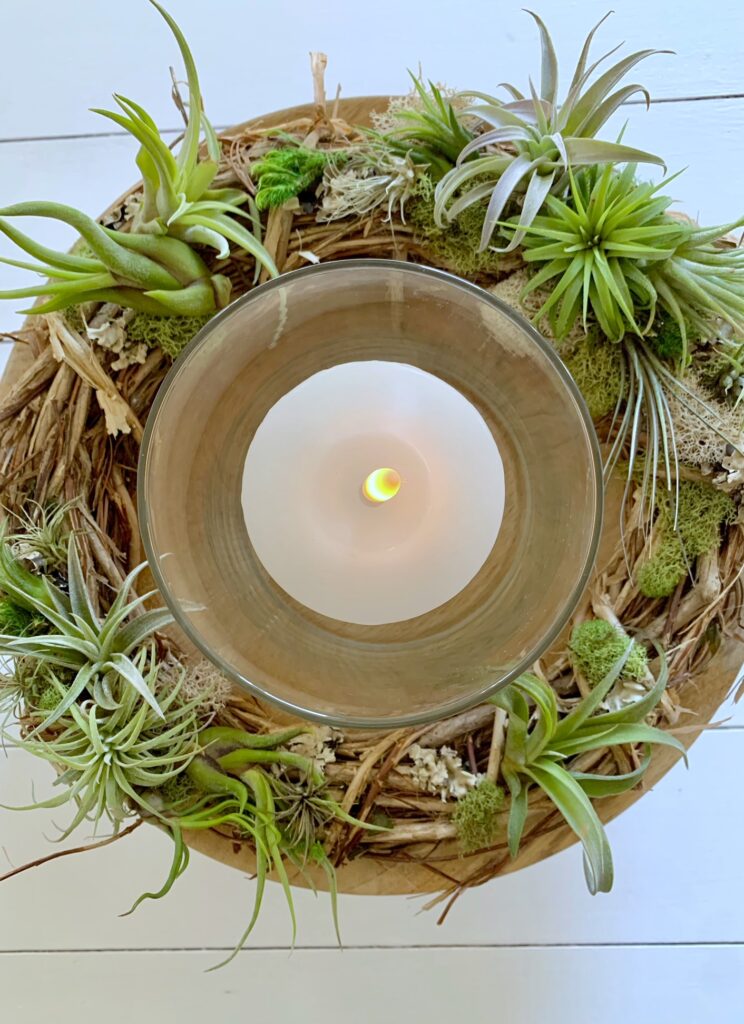
DIY Air plant Candle Ring instructions.
Troubleshooting Common Watering Problems
- Signs of Overwatering:
- Wrinkled or shriveled leaves
- Yellow or translucent leaves
- Foul odor
- Algae growth
- Rotting base
- Signs of Underwatering:
- Curled or rolled leaves
- Dry, crispy foliage
- Slow growth or stunted development
- Tilted or wilted appearance
- Brown leaf tips
- Water Quality Issues:
- Hard water stains on leaves
- Salt buildup on leaves
- Chlorine or fluoride damage
- Using tap water instead of rainwater
- Inadequate drying after watering
- Improper Watering Techniques:
- Using the soak method for xeric plants
- Frequent watering for mesic plants
- Inconsistent watering schedule
- Overcrowding in containers or arrangements
- Water air plants during the hottest part of the day
- Mounted vs. Unmounted Plant Challenges:
- Mounted plants may be challenging to fully saturate
- Loose/unmounted plants are easier to soak
- Difficulty in assessing moisture levels in mounted displays
- Unmounted plants have better airflow for drying
- Inadequate Drying After Watering:
- Not allowing the plant to dry completely
- Water accumulating in crevices or between leaves
- Placing air plants in enclosed containers without airflow
- Failing to remove excess water from the base
- Choosing the Wrong Watering Method:
- Not tailoring watering methods to the plant’s trichome structure
- Neglecting seasonal adjustments in watering frequency
- Using standing water instead of misting when needed
- Ignoring the environmental humidity level
- Inadequate Air Circulation:
- Poor ventilation in the growing area
- Enclosed terrariums or containers without airflow
- Overcrowded displays hindering proper drying
- Failing to shake or gently fan the plants after watering
- Improper drying of mounted plants
- Too much Direct Sunlight:
- Excessive exposure to direct sunlight can be detrimental to air plants. Too much light can lead to a range of issues, including sunburn, leaf desiccation, and heat stress. When air plants receive more sunlight than they can handle, their leaves may develop brown or white spots, become overly dry and crispy, or exhibit signs of wilting.
Remember to address these common watering problems to ensure your air plants thrive and maintain their health and vitality.
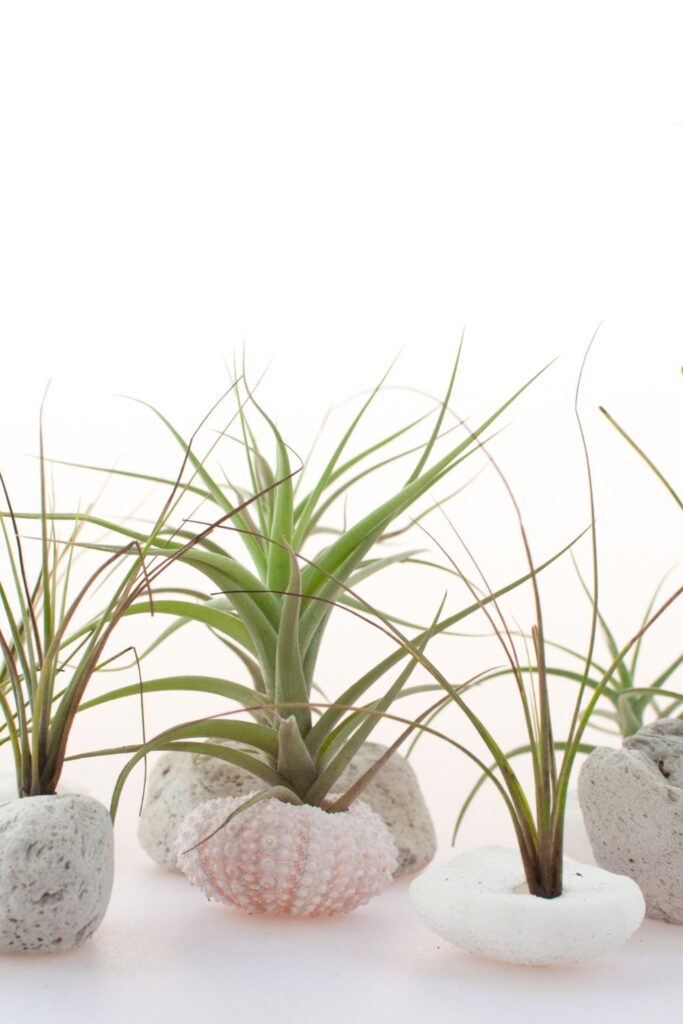
My Tip on The Best Type of Water for Your Plants
When watering your air plants, don’t use chlorinated water as it can harm them. Instead, use rainwater, pond water or distilled water if possible. If you want to use tap water, allow it to sit out in a bowl for 24 hours first so that the chlorine evaporates. Also when soaking use room-temperature water so you don’t shock the plants.
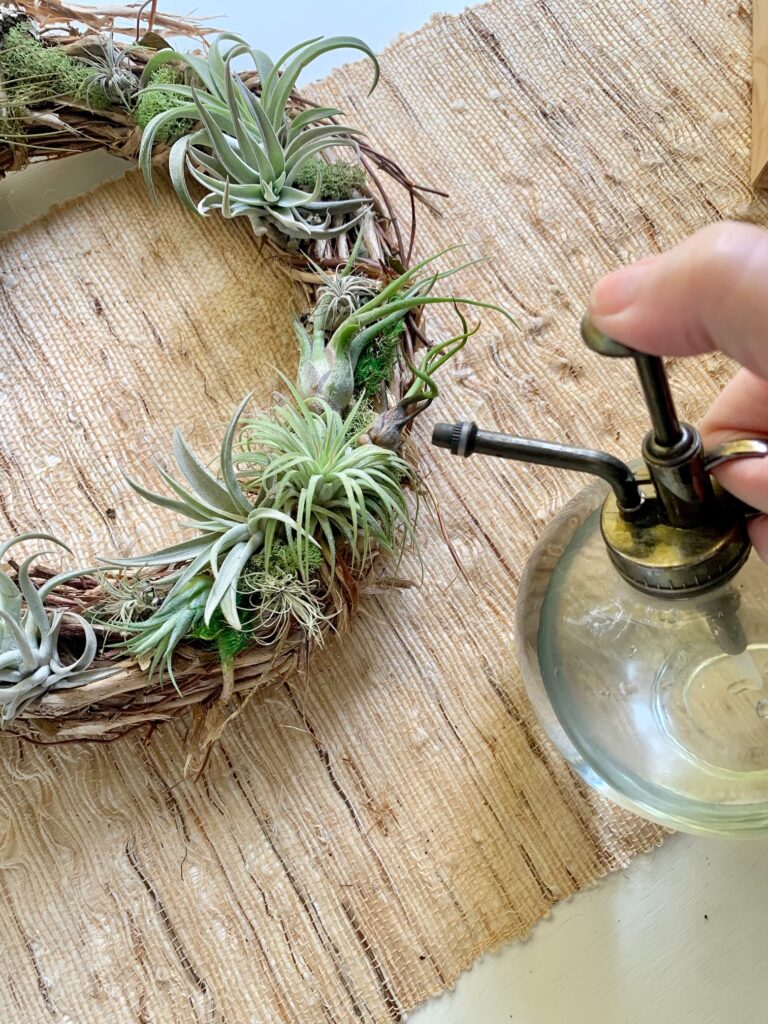
Frequently Asked Questions on Watering Air Plants
They will be thriving! Always use the best water possible (rain water, pond water, or unfiltered water). Use the soaking method shared below with occasional misting. Most importantly watch how your plants are responding to their care. A happy air plant is healthy looking, growing and if it’s a flowering variety – blooming!
A good soak is in order! You may want to try soaking for several hours or overnight. Then remove the air plants and set them upside down until dry. In the future consider more frequent watering or perhaps reducing the amount of sun exposure your plant is receiving. Hopefully, this extended soak will get your plant heading back in the right direction.
An overwatered air plant is a lot harder to rescue than a dry plant, so if you spot any signs of rotting, stop watering immediately until it begins to turn around. Signs of overwatering include center leaves falling out or the base of the plant begins to turn black or brown, The base may also turn mushy – these are signs that it’s beginning to rot from too much water. Remove any damaged parts and place the plant in a sunny spot. Keep in mind good air circulation is essential and xeric types do not need a lot of watering.
Xeric air plants benefit from less frequent watering. Consider the dunking method by immersing them in water or misting them to maintain their water balance without over-soaking.
Mesic air plants prefer more consistent moisture. Soaking is an excellent method for ensuring they receive the necessary hydration. However, always consider their individual needs and adjust the frequency based on the plant’s health.
Some xeric air plants may thrive with minimal watering, relying mainly on misting. However, understanding the unique needs of each air plant is crucial to determine the appropriate watering technique.
I highly recommend checking out my complete care guide – How to Keep Air Plants Alive: Tips for Thriving Tillandsias. This in-depth post shares all my best tips and advice for providing the ideal sunlight, watering properly, increasing humidity, troubleshooting issues, creative display ideas, and more. It’s the perfect beginner’s guide covering everything you need to know to keep your air plants healthy and happy!
Step-by-step Instructions for Soaking Air Plants
How to Soak Air Plants
Equipment
- 1 bowl
- 4 cups water (room temperature/non chloraniated)
- 1 (or more) air plants
- 1 cloth towel or paper towel
Instructions
- Fill a clean bowl with enough water to submerge your air plants. The water should be room temperature and chlorine free. Note: Air plants tend to float which is not a problem. Just submerge and then let them float.
- Let the air plants soak for 1-3 hours.
- Remove the air plants from the water and discard the soaking water. Gently shake the excess water to get the water out from center of the plant and sit the air plant upside down on a paper towel.
- Allow Air plants to fully dry before placing the plant(s) back in your air plant display. Always place Air plants in a sunny spot recieving indirect light.
Notes
Most importantly, while air plants are low maintenance and easy care plants it takes some practice to nail down a consistent, effective watering routine. Watch them… look for signs of overwatering or underwatering. When it comes to plant parenting having guidelines is helpful however the best way to care for your green babies is by simply checking in on them on a regular basis and making adjustments as needed. If you pay attention almost all plants with let you know what they need!
Thank you for visiting the blog today for this How Often to Mist Air Plants: A Complete Guide blog post. If you haven’t already read Part 1, Do Air Plants Need Sun? (Choosing The Ideal Spot) please do. Also, Part 3, Where to Buy Air Plants is available now! This post includes a fun idea for displaying your air plants.
For more plant care please visit my Indoor Plant Fertilizers You Can Make at Home (Feed Your Plants the Natural Way) post where we discuss using natural waste materials at home to make fertilizer.
Keep Growing Friends!


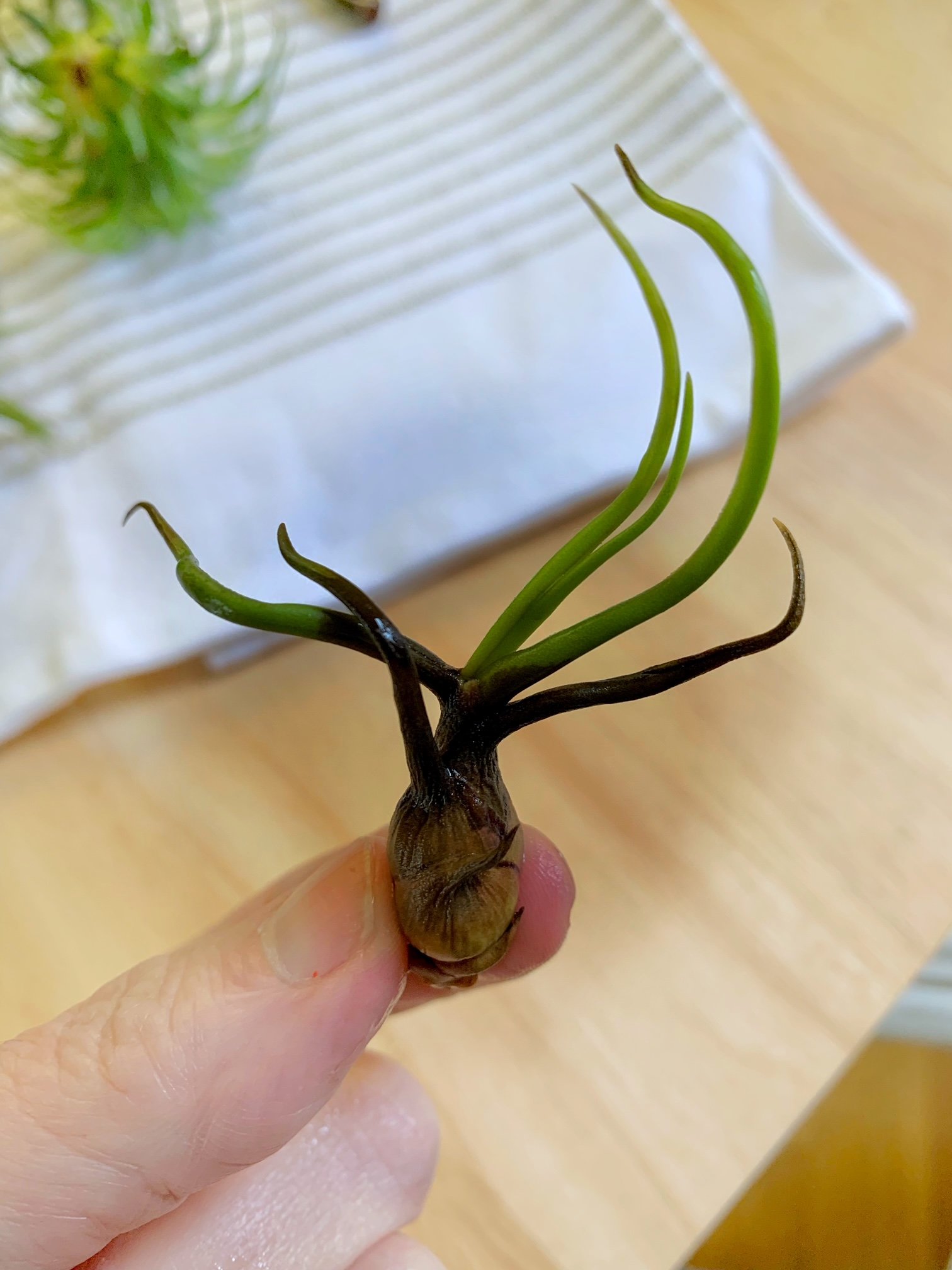
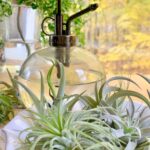
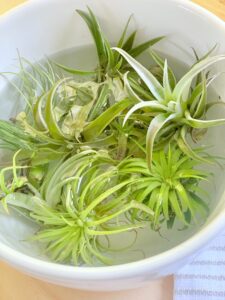
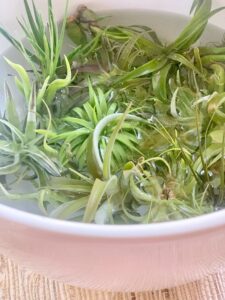
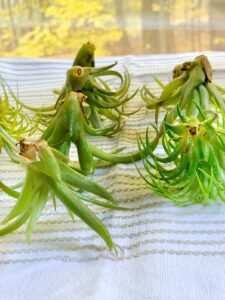
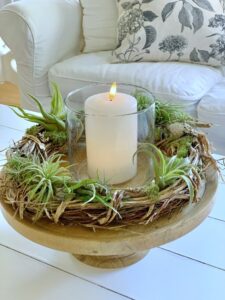
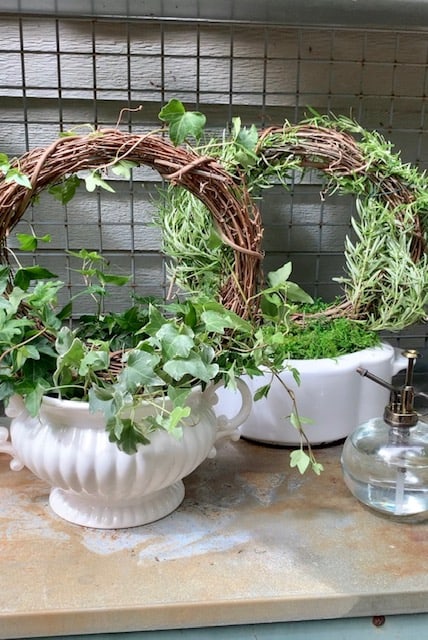
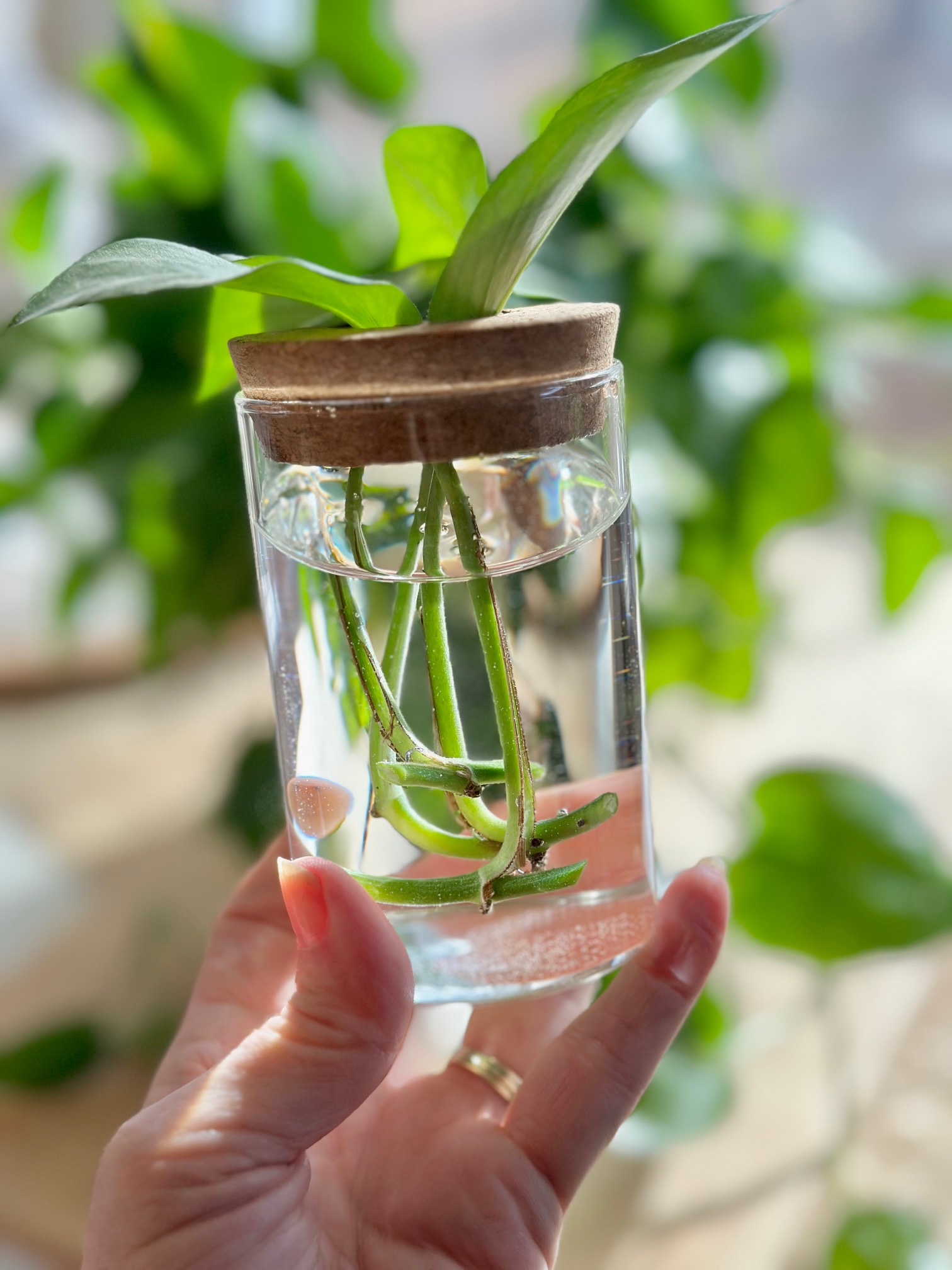
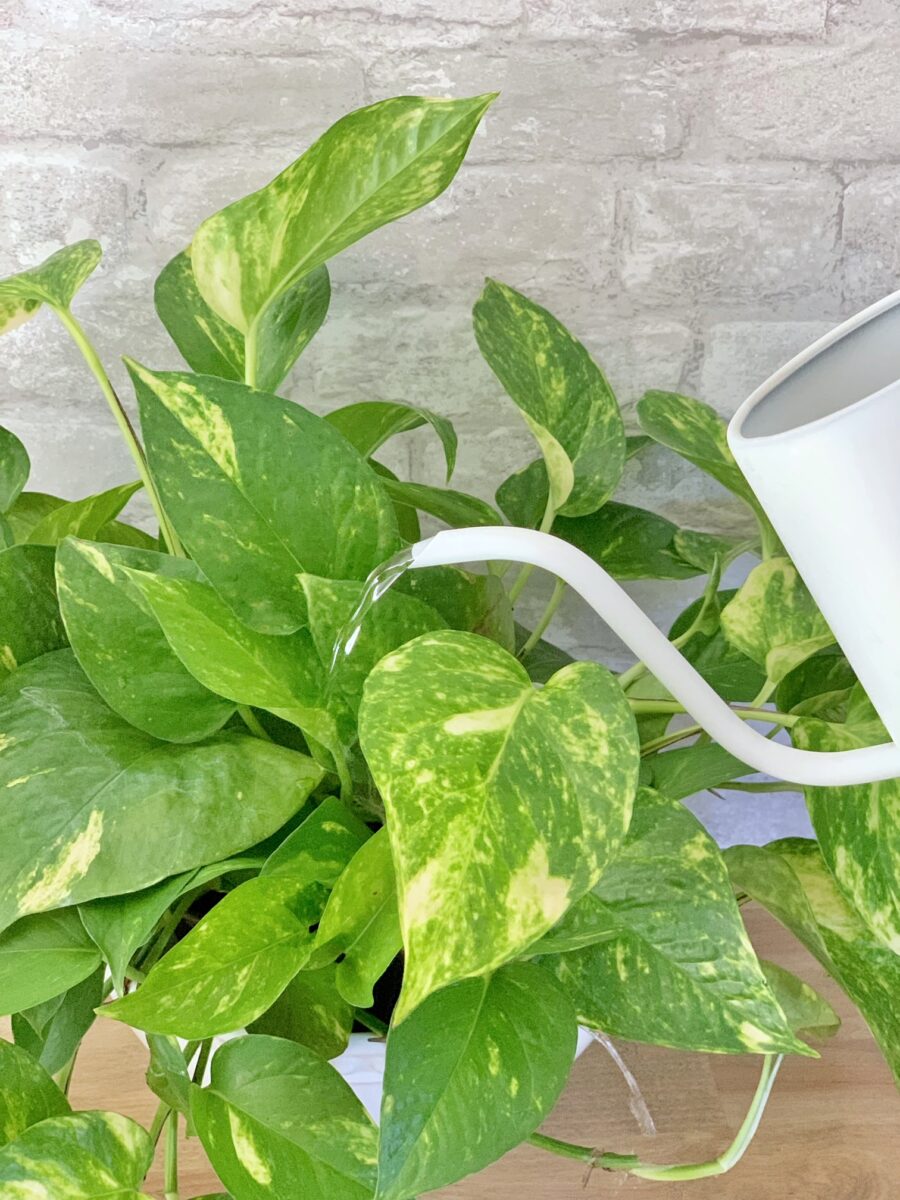
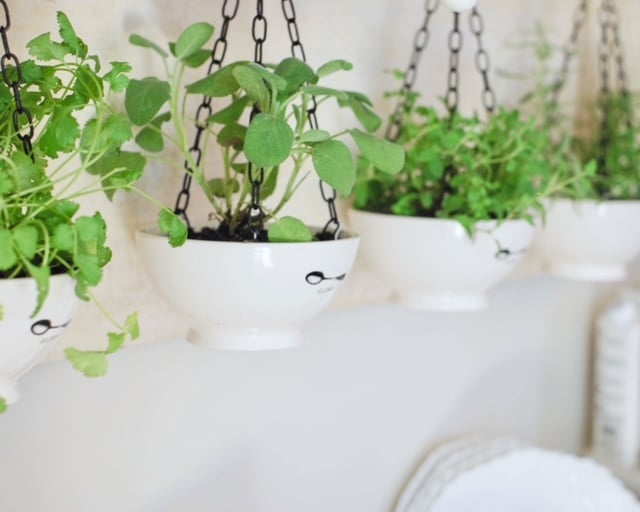
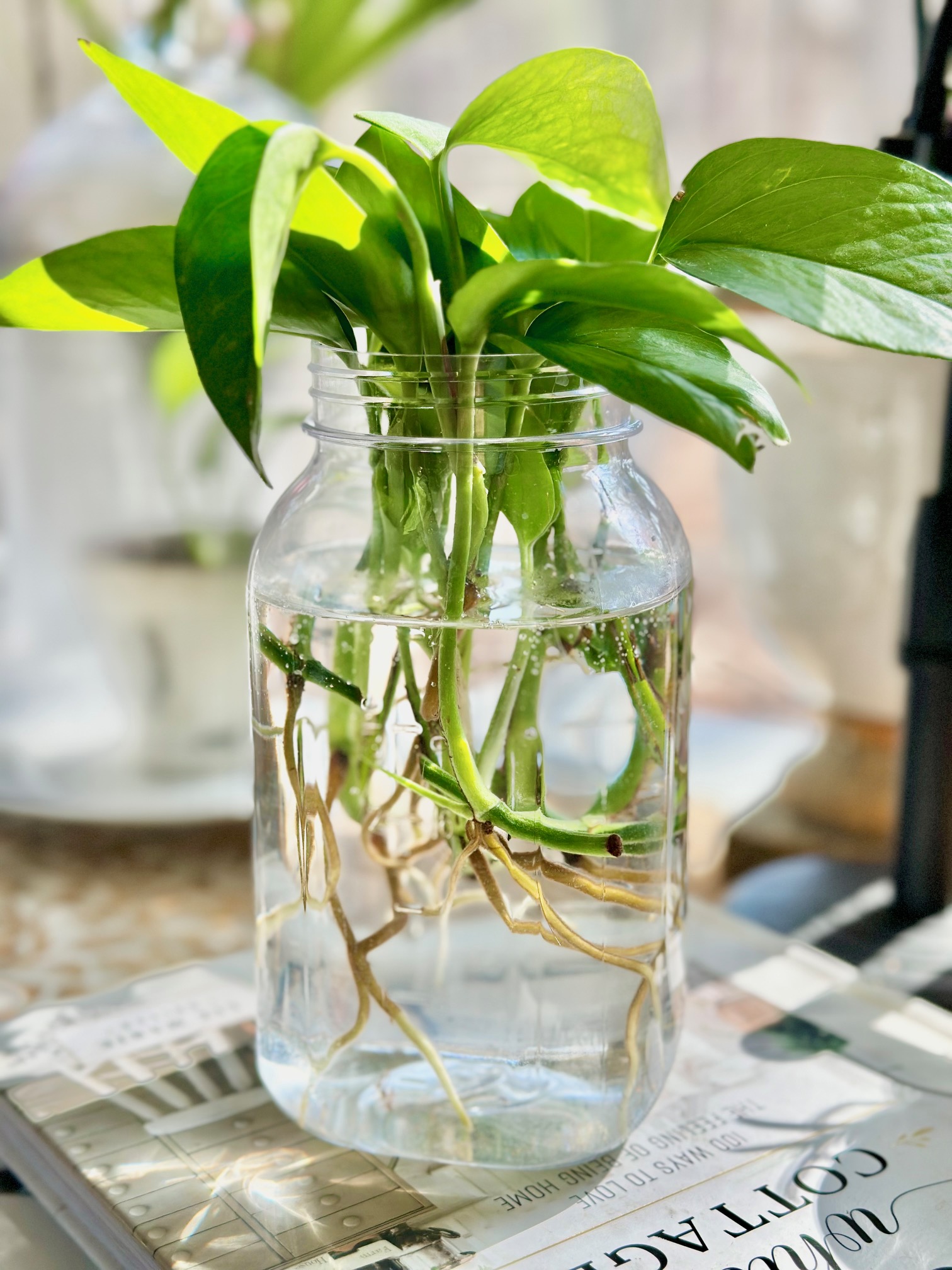
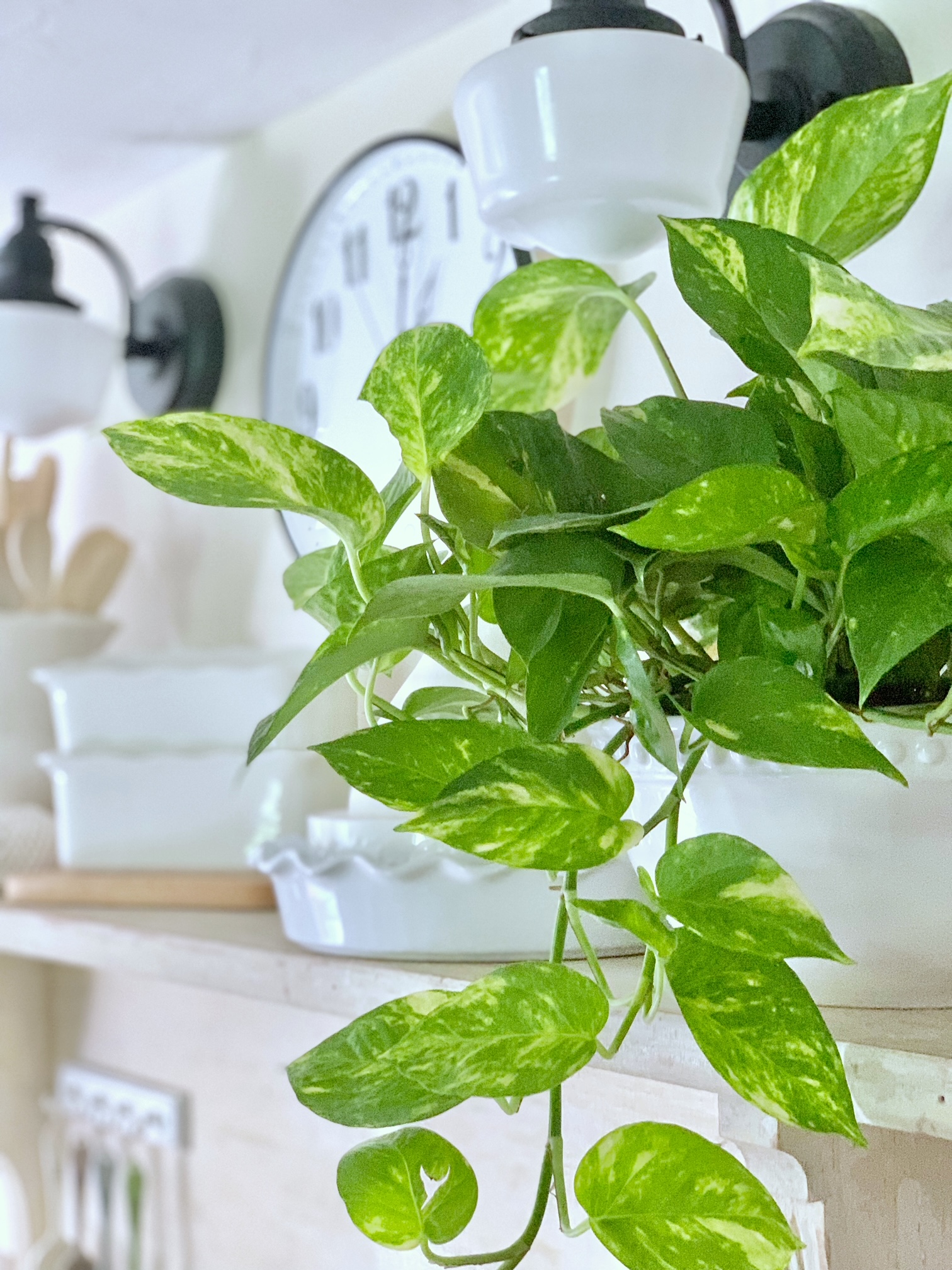
Thanks for the great advice and practical insights for raising my airplanes. I’m not sure which kinds are mesa or humid-zone plants, so I’ll have to observe and experiment I guess.
Again, your blog is truly appreciated.
Fr Thomas+
Thank you Thomas!
Thank you for all the know how’s and dos and don’ts
I love my babies
You are welcome! Thank you for visiting the blog!!
hi-ya, glorious blog on lardy loss. that helped.